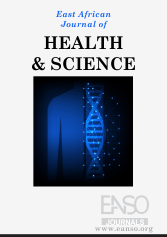Evaluation of the anti-radical activity of two plant extracts: Ficus thonningii and Acacia nilotica, used by the korhogo population in the north of the Ivory Coast
Abstract
The objective of this work was to evaluate the anti-radical power of ethanolic and aqueous extracts of Ficus thonningii and Acacia nilotica, two plants widely used by the population of Korhogo, in the north of Ivory Coast. Phytochemical screening was carried out by the tube staining and precipitation method. As for the determination of total polyphenols, it was done using the colorimetric technique of Folin −Ciocalteur then using a calibration line Y= ax + b, while that of total flavonoids and tannins was determined through a spectrophometer with absorbance read respectively at 404 nm with quercetol as standard and 500 nm (catechin as standard). Finally, the antioxidant activity carried out by the DPPH method. The results obtained revealed the presence of several secondary metabolites including polyphenols, flavonoids, anthocyanins and tannins. The 50% free radical inhibitory concentrations (IC50) of the different Acacia nilotica extracts were 0.0044 mg/mL for the ethanolic extract and 0.0047 mg/mL for the aqueous extract. This result is very close to that of vitamin C (0.0036 mg/mL) taken as the reference molecule, while the IC50 of Ficus thonningii are respectively 0.0194 mg/mL and 0.083 mg/mL for the ethanolic extract. and watery. We note that the extracts have good anti-radical power but that the best remains the ethanolic and aqueous extracts of Acacia nolitica.
Downloads
References
Al-Farsi M, Alasalvar C, Morris A, Barron M, Shahidi F. (2005). Comparison of Antioxidant Activity, Anthocyanins, Carotenoids, and Phenolics of Three Native Fresh and Sun-Dried Date (Phoenix dactylifera L.) Varieties Grown in Oman. J. Agric. Food Chem, 53: 7592-7599. DOI: 10.1021/jf050579q
Alhazmi, H.A., Najmi, A., Javed, S.A., Sultana, S., Al Bratty, M., Makeen, H.A., Meraya, A.M., Ahsan, W., Mohan, S., Taha, M.M.E., Khalid, A., (2021). Medicinal plants and isolated molecules demonstrating immunomodulation activity as potential alternative therapies for viral diseases including COVID-19. Front Immunol., 12:637553.
Delattre J, Thérond P, Bonnefont-Rousselot D. (2005). Reactive oxygen species, antioxidants and aging. In: Delattre JB, Bonnefont-Rousselot D, eds. Free radicals and oxidative stress. Biological and pathological aspects. Paris: Lavoisier, 281-309
Doukani, Asmae; Hardy, Amy ; (2017). The PCL as a brief screen for posttraumatic stress disorder within schizophrenia. International journal of psychiatry in clinical practice, 21 (2). pp. 148-150. ISSN 1365-1501 D
Dosseh K, Kpatcha T, Adjra Y, Idoh K, Agbonon A, Gbeassor M. (2014). Antiinflamatory effect of Byrsocarpus coccineus Schum. And Thonn. (Connaraceae) root. Word Journal of Pharmaceutical Research, 3(3): 3585- 3598
Gbolo Z., Ciala N., Ngbolua K., Tshibangu D., Tshilanda D., Memvanga B., Mpiana P. (2022). Phytochemical profiling by high-performance thin layer chromatography of total flavonoid extracts from Drepanoalpha® and evaluation of their antisickle cell activity in vitro. African Annals of Medicine, 16:e4882-e4898
Hariri E.B., Sallé G., Andary C. (1991). Involvement of flavonoids in the resistance of two poplar cultivars to mistletoe (Viscum album L.), Protoplasma Vol. 162, No. 1, pp. 20-26.
Iffat habib syed shahid ali and tanzeela riaz, (2009). Screening and characterization of alkaliphilic bacteria from industrial effluents. Punjab Univ. J. Zool., Vol. 24 (1-2), pp. 49-60
Kapepula, P.M., Ngombe, N.K., Tshibangu, P.T., Tsumbu, C., Franck, T., MouithysMickalad, A., Mumba, D., Tshala-Katumbay, D., Serteyn, D., Tits, M., Angenot, L., Kalenda, P.D.T., Frédérich, M., (2017). Comparison of metabolic profiles and bioactivities of the leaves of three edible congolese hibiscus species. Natural Product Research, 31: 2885-2892.
Khaldi A, Meddah B, Moussaoui A, Benmehdi H et Gouri S. (2012). Screening Phytochimique et Effet Antifongique de Certains Extraits de Plantes Sur le Développement in Vitro des Moisissures. European Journal of Scientific Research, 80: 311-321.
Longaga A. Otshudi, Vercruysse A. & Foriers A., (2000). Contribution to the ethnobotanical,
phytochemical and pharmacological studies of traditionally used medicinal plants in the
treatment of dysentery and diarrhoea in Lomola area, Democratic Republic of Congo (RDC). J. Ethnopharmacologie. 71: 411-423
Morel Y, Barouki R. (1998). Influence du stress oxydant sur la régulation des gènes. Med Sci (Paris); 14 : 713-21
N’gaman k.c.c., Bekro y-a., Bamyrbekova-bekro j. a., Benie a., Goore s., (2009). On the Secondary Metabolite Composition and Antioxidant Activity of Raw Extracts of Gmelina Arborea Roxb. (Verbanaceae) from Ivory Coast, West Africa: Analysis by Thin Layer Chromatography. Eur. J.Sci. Res., Vol. 36, No. 2, pp. 161-171,
Singleton V.L., Ortofer R., Lamuela-raventos R.M., (1999). Analysis of total phenols and other oxidation substrates and antioxidants by means of Folin-Ciocalteu reagent. Packer L (ed) Methods in enzymology Orlando Academic Press: pp. 152-178.
Sofowora, A. (2008). Medicinal plants of Traditional Medicine in Africa. 3rd Edition,
Spectrum Books, Ibadan, Nigeria. 199- 181.
Tona L., Kambu K., Ngimbi N., Cimanga K. & Vlietinck A. J., (1998). Antiamoebic and
phytochemical screening of some Congolese medicinal plants. J. Ethnopharm. 61: 57-65.
Wangcharoen W, Morasuk W (2007a). Antioxidant capacity and phenolic content of some Thai culinary plants. Maejo Inter J Sci Technol 1(2):100–106
Copyright (c) 2025 Traore Youssouf Zanga, Kande Brahima, Kouadio Nathalie Guessennd

This work is licensed under a Creative Commons Attribution 4.0 International License.




























